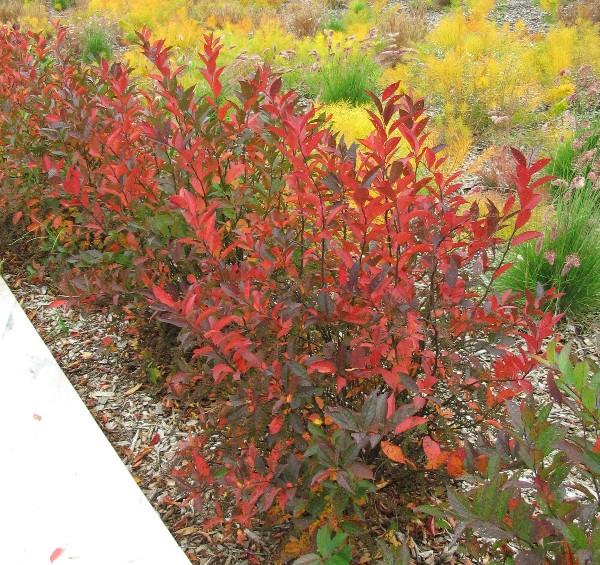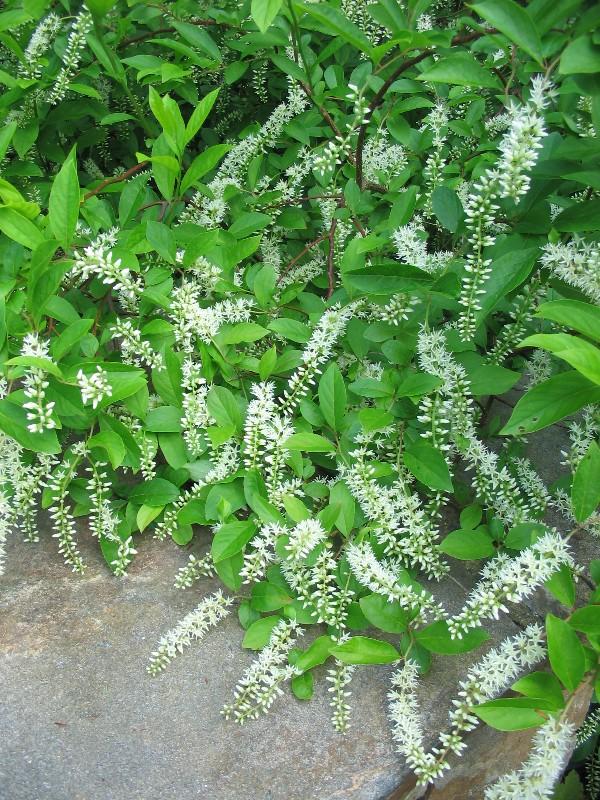About Virginia sweetspire
Itea virginica
Deciduous shrub
Maryland Distribution: Coastal Plain
Height: 6 to 10 feet
Flowers: small white flowers gathered on 3-to-6 inch long racemes, showy, fragrant; blooms May-June
Fall color: orange - red - burgundy
Sun: Full sun to shade
Soil: any soil texture; moist to wet; high organic matter; pH 5.1-7.5
Garden Uses: This deciduous shrub is native to the mid-Atlantic and southeastern United States and is adapted to the Maryland Coastal Plain. In natural habitats, it is found primarily in moist soils along stream banks, woodland floodplains, and swamps. It can tolerate periodic flooding up to 6 inches. It has a densely-branched form, with “spires” of fragrant white flowers produced on the previous season’s growth. Prune after flowering, if desired. On unpruned plants, brown seed capsules persist on the branches in the fall to winter. This shrub spreads by root suckering and can form dense colonies. It tolerates drier soil once established.
Use Virginia sweetspire for a hedge, erosion control, woodland or pond edge, or a rain garden. It is a good native alternative to invasive Japanese barberry for showy autumn foliage.
Wildlife: This shrub provides cover, nesting habitat, and seeds for birds. It also supports bumblebees, butterflies, and hummingbirds. Deer-resistant.


Reference
Slattery, Britt E., et. al. 2005. Native Plants for Wildlife Habitat and Conservation Landscaping, U.S. Fish & Wildlife, Chesapeake Bay Field Office, Annapolis, MD. 82 pp.
 English
English العربية
العربية Български
Български 简体中文
简体中文 繁體中文
繁體中文 Hrvatski
Hrvatski Čeština
Čeština Dansk
Dansk Nederlands
Nederlands Suomi
Suomi Français
Français Deutsch
Deutsch Ελληνικά
Ελληνικά हिन्दी
हिन्दी Italiano
Italiano 日本語
日本語 한국어
한국어 Norsk bokmål
Norsk bokmål Polski
Polski Português
Português Română
Română Русский
Русский Español
Español Svenska
Svenska Català
Català Filipino
Filipino עִבְרִית
עִבְרִית Bahasa Indonesia
Bahasa Indonesia Latviešu valoda
Latviešu valoda Lietuvių kalba
Lietuvių kalba Српски језик
Српски језик Slovenčina
Slovenčina Slovenščina
Slovenščina Українська
Українська Tiếng Việt
Tiếng Việt Shqip
Shqip Eesti
Eesti Galego
Galego Magyar
Magyar Maltese
Maltese ไทย
ไทย Türkçe
Türkçe فارسی
فارسی Afrikaans
Afrikaans Bahasa Melayu
Bahasa Melayu Kiswahili
Kiswahili Gaeilge
Gaeilge Cymraeg
Cymraeg Беларуская мова
Беларуская мова Íslenska
Íslenska Македонски јазик
Македонски јазик יידיש
יידיש Հայերեն
Հայերեն Azərbaycan dili
Azərbaycan dili Euskara
Euskara ქართული
ქართული Kreyol ayisyen
Kreyol ayisyen اردو
اردو বাংলা
বাংলা Bosanski
Bosanski Cebuano
Cebuano Esperanto
Esperanto ગુજરાતી
ગુજરાતી Harshen Hausa
Harshen Hausa Hmong
Hmong Igbo
Igbo Basa Jawa
Basa Jawa ಕನ್ನಡ
ಕನ್ನಡ ភាសាខ្មែរ
ភាសាខ្មែរ ພາສາລາວ
ພາສາລາວ Latin
Latin Te Reo Māori
Te Reo Māori मराठी
मराठी Монгол
Монгол नेपाली
नेपाली ਪੰਜਾਬੀ
ਪੰਜਾਬੀ Afsoomaali
Afsoomaali தமிழ்
தமிழ் తెలుగు
తెలుగు Yorùbá
Yorùbá Zulu
Zulu ဗမာစာ
ဗမာစာ Chichewa
Chichewa Қазақ тілі
Қазақ тілі Malagasy
Malagasy മലയാളം
മലയാളം සිංහල
සිංහල Sesotho
Sesotho Basa Sunda
Basa Sunda Тоҷикӣ
Тоҷикӣ O‘zbekcha
O‘zbekcha አማርኛ
አማርኛ Corsu
Corsu Ōlelo Hawaiʻi
Ōlelo Hawaiʻi كوردی
كوردی Кыргызча
Кыргызча Lëtzebuergesch
Lëtzebuergesch پښتو
پښتو Samoan
Samoan Gàidhlig
Gàidhlig Shona
Shona سنڌي
سنڌي Frysk
Frysk isiXhosa
isiXhosa